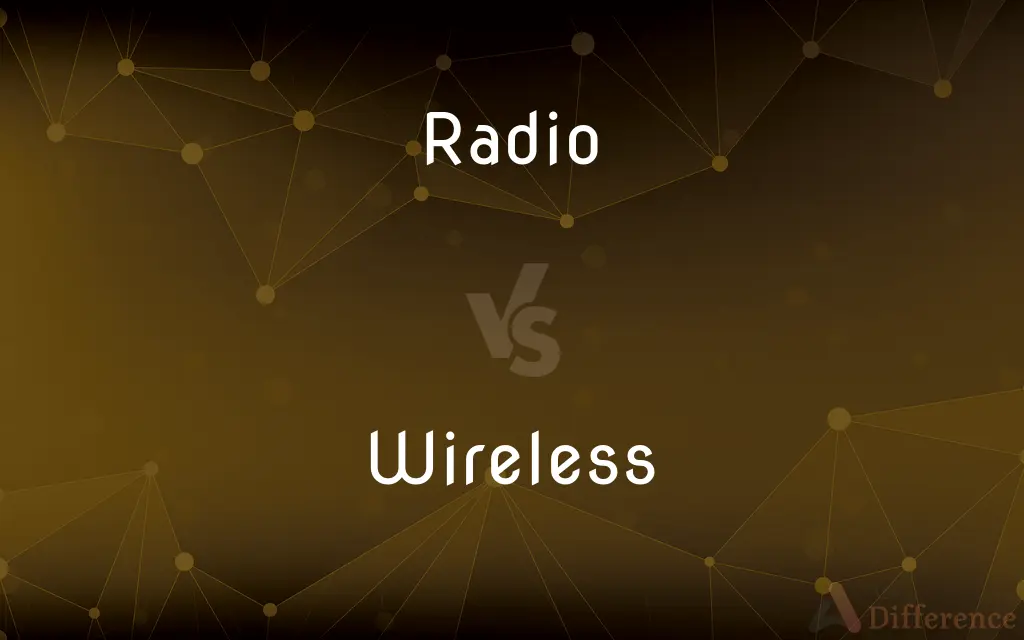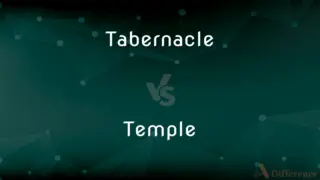Radio vs. Wireless — What's the Difference?
By Fiza Rafique & Maham Liaqat — Updated on March 27, 2024
Radio refers to technology using radio waves for communication, while wireless is a broader term for any communication without physical connections.

Difference Between Radio and Wireless
Table of Contents
ADVERTISEMENT
Key Differences
Radio technology specifically uses electromagnetic waves in the radio frequency range to transmit information, such as sound or data, over distances without wires. It is a subset of wireless technology, focusing primarily on audio broadcasts (like AM/FM stations) and certain types of data transmission. On the other hand, wireless encompasses a wider range of technologies, including Wi-Fi, Bluetooth, and cellular networks, which use various parts of the electromagnetic spectrum to facilitate cordless connectivity and data exchange.
Radio has a long history, dating back to the late 19th and early 20th centuries, playing a crucial role in mass communication, entertainment, and even in emergencies as a reliable means of disseminating information. Wireless technology, while benefiting from the foundational principles of radio, has evolved to support a vast array of modern applications, from mobile phone communications to the Internet of Things (IoT), making it integral to contemporary digital life.
In terms of application, traditional radio technology is often associated with broadcasting, where a central transmitter sends signals to numerous receivers. This one-to-many communication model is prevalent in commercial radio stations and emergency alert systems. Wireless technology, however, facilitates both one-to-one (like Bluetooth pairing devices) and one-to-many communications, offering greater flexibility for personal and professional use.
From a technical standpoint, radio frequencies (RF) are just a part of the electromagnetic spectrum used by wireless technologies. Wireless communications can employ not only RF but also infrared, microwave, and even light (such as Li-Fi) to transmit data. This distinction highlights the broader applicability and versatility of wireless technologies compared to traditional radio.
Finally, the regulatory landscape for radio is well-established, with frequencies carefully allocated and managed to prevent interference between different users and services. Wireless technology also faces regulatory scrutiny, but the breadth of technologies and applications under its umbrella introduces more complexity to spectrum management and device certification, reflecting its more diverse and rapidly evolving nature.
ADVERTISEMENT
Comparison Chart
Definition
Use of radio waves for communication.
Communication technology without physical connections.
Scope
Mainly audio broadcasts and data transmission.
Includes Wi-Fi, Bluetooth, cellular networks, etc.
History
Dates back to late 19th century.
Evolved from radio with broader applications.
Communication Model
Primarily one-to-many (broadcasting).
Both one-to-one and one-to-many.
Frequency Range
Uses specific parts of the RF spectrum.
Utilizes RF, infrared, microwave, and light.
Compare with Definitions
Radio
A technology using radio waves to transmit information.
The emergency broadcast was transmitted via radio.
Wireless
Refers to any technology that communicates without direct physical connections.
Wireless headphones connect to phones via Bluetooth.
Radio
Used for one-to-many communication.
Radio stations broadcast music and news to a wide audience.
Wireless
Encompasses a broad range of technologies.
Wireless technologies include Wi-Fi, cellular networks, and Bluetooth.
Radio
Operates on specific frequencies.
FM radio operates from 87.5 to 108.0 MHz.
Wireless
Continuously evolving with new standards.
Wi-Fi 6 introduces faster speeds and improved efficiency for wireless internet.
Radio
Historically significant in communication.
Radio was crucial for communication during World War II.
Wireless
Facilitates mobility and convenience.
Wireless charging pads allow for cable-free phone charging.
Radio
Can refer to a device receiving radio broadcasts.
She listened to the news on her car radio.
Wireless
Used in various applications from personal to industrial.
Wireless sensors monitor conditions in smart homes.
Radio
Radio is the technology of signaling and communicating using radio waves. Radio waves are electromagnetic waves of frequency between 30 hertz (Hz) and 300 gigahertz (GHz).
Wireless
Wireless communication (or just wireless, when the context allows) is the transfer of information between two or more points that do not use an electrical conductor as a medium by which to perform the transfer. The most common wireless technologies use radio waves.
Radio
Electromagnetic radiation with lower frequencies and longer wavelengths than those of microwaves, having frequencies lower than 300 megahertz and wavelengths longer than 1 meter.
Wireless
Having no wires.
Radio
The transmission and reception of electromagnetic waves within this range, especially when convertible to audible sounds
The use of radio in warfare.
Wireless
Of or relating to communication by transmitting electromagnetic signals through the air
A wireless network.
A wireless telephone.
Radio
A device, such as a walkie-talkie, that transmits or receives such signals.
Wireless
Chiefly British Of or relating to radio or communication by radiotelegraphy or radiotelephony.
Radio
The system or industry that broadcasts programs of audio content to the public or subscribers by means of radio waves or over the internet
She was famous during the early days of radio.
Wireless
A radio telegraph or radiotelephone system.
Radio
Audio content, especially short programs or sets of songs, created for or distributed through such a system
Listening to radio.
Wireless
A message transmitted by wireless telegraph or telephone.
Radio
An electronic device for listening to radio programming, consisting of a tuner and speakers.
Wireless
Chiefly British Radio.
Radio
To transmit by radio
Radio a message to headquarters.
Wireless
To communicate with or send communications by wireless.
Radio
To transmit a message to by radio
Radioed the spacecraft.
Wireless
Not having any wires.
Radio
To transmit messages or a message by radio
A ship radioing for help.
Wireless
Of or relating to communication without a wired connection, such as by radio waves.
Radio
(uncountable) The technology that allows for the transmission of sound or other signals by modulation of electromagnetic waves.
Send a message by radio
Wireless
(uncountable) The medium of radio communication.
Only about a hundred years ago, wireless was a new technology.
Radio
(countable) A device that can capture (receive) the signal sent over radio waves and render the modulated signal as sound.
We heard a lovely song on the radio.
Wireless
Wireless connectivity to a computer network.
If your wireless stops working, try restarting the router.
Radio
(countable) On-board entertainment system in a car, usually including a radio receiver as well as the capability to play audio from recorded media.
Wireless
A radio set.
Let's switch on the wireless and listen to the news.
Radio
(countable) A device that can transmit radio signals.
Wireless
To send a message by wireless (by radio)
Radio
The continuous broadcasting of sound via the Internet in the style of traditional radio.
Wireless
Having no wire;
Radio
(ambitransitive) To use two-way radio to transmit (a message) (to another radio or other radio operator).
I think the boat is sinking; we'd better radio for help. / I radioed him already. / Radio the coordinates this time. / OK. I radioed them the coordinates.
Wireless
Short for Wireless telegraphy, Wireless telephony, etc.; as, to send a message by wireless.
Radio
(transitive) To order or assist (to a location), using telecommunications.
Wireless
Medium for communication
Radio
Medium for communication
Wireless
Transmission by radio waves
Radio
An electronic receiver that detects and demodulates and amplifies transmitted signals
Wireless
An electronic receiver that detects and demodulates and amplifies transmitted signals
Radio
A communication system based on broadcasting electromagnetic waves
Wireless
A communication system based on broadcasting electromagnetic waves
Radio
Transmit messages via radio waves;
He radioed for help
Wireless
Having no wires;
A wireless security system
Radio
Indicating radiation or radioactivity;
Radiochemistry
Common Curiosities
Can radio operate without the internet?
Yes, traditional radio broadcasts do not require the internet and rely on radio waves transmitted over the air.
How do radio broadcasts reach our devices?
Radio broadcasts are transmitted over radio waves from a station's transmitter and are picked up by receivers tuned to the specific frequency.
What distinguishes radio from other wireless technologies?
Radio specifically uses radio waves for broadcasting and communication, while wireless encompasses a broader range of technologies without physical connections.
Are all wireless technologies based on radio waves?
While many wireless technologies use radio waves, others use different parts of the electromagnetic spectrum, like infrared or microwave.
What are the advantages of wireless over wired connections?
Wireless offers greater mobility and flexibility, reducing the need for physical cables and allowing devices to connect from anywhere within range.
How do regulatory bodies manage radio frequencies?
Regulatory bodies allocate specific frequency bands for different uses to prevent interference, ensuring efficient and safe communication.
What is the future of radio in the digital age?
Radio continues to evolve, integrating with digital platforms to reach wider audiences and offering digital broadcasting options like DAB.
What are the security concerns with wireless technology?
Wireless connections can be more vulnerable to eavesdropping and hacking compared to wired connections, necessitating robust security measures.
How does Bluetooth differ from traditional radio?
Bluetooth is a short-range wireless technology for connecting devices, using radio waves but designed for personal area networks.
Is Wi-Fi considered a form of radio?
Wi-Fi is a form of wireless communication that uses radio waves, specifically in the 2.4 GHz and 5 GHz bands, to transmit data.
Can wireless technology replace all wired connections?
While wireless technology provides many advantages, wired connections still offer more stable and secure connections for some applications.
How has wireless technology impacted the internet?
Wireless technology has revolutionized internet access, providing flexibility and connectivity without the limitations of physical cables.
What role does radio play in emergency communications?
Radio is vital for emergency communications due to its reliability and wide reach, making it effective for public alerts and disaster response.
How do microwave transmissions fit into the wireless category?
Microwave transmissions, used for long-distance communication and satellite links, are a form of wireless communication using higher frequency radio waves.
What advancements are expected in wireless technology?
Future advancements include faster data speeds, lower latency, and the expansion of IoT, enhancing connectivity and smart device integration.
Share Your Discovery

Previous Comparison
Tabernacle vs. Temple
Next Comparison
Act vs. ProcessAuthor Spotlight
Written by
Fiza RafiqueFiza Rafique is a skilled content writer at AskDifference.com, where she meticulously refines and enhances written pieces. Drawing from her vast editorial expertise, Fiza ensures clarity, accuracy, and precision in every article. Passionate about language, she continually seeks to elevate the quality of content for readers worldwide.
Co-written by
Maham Liaqat















































